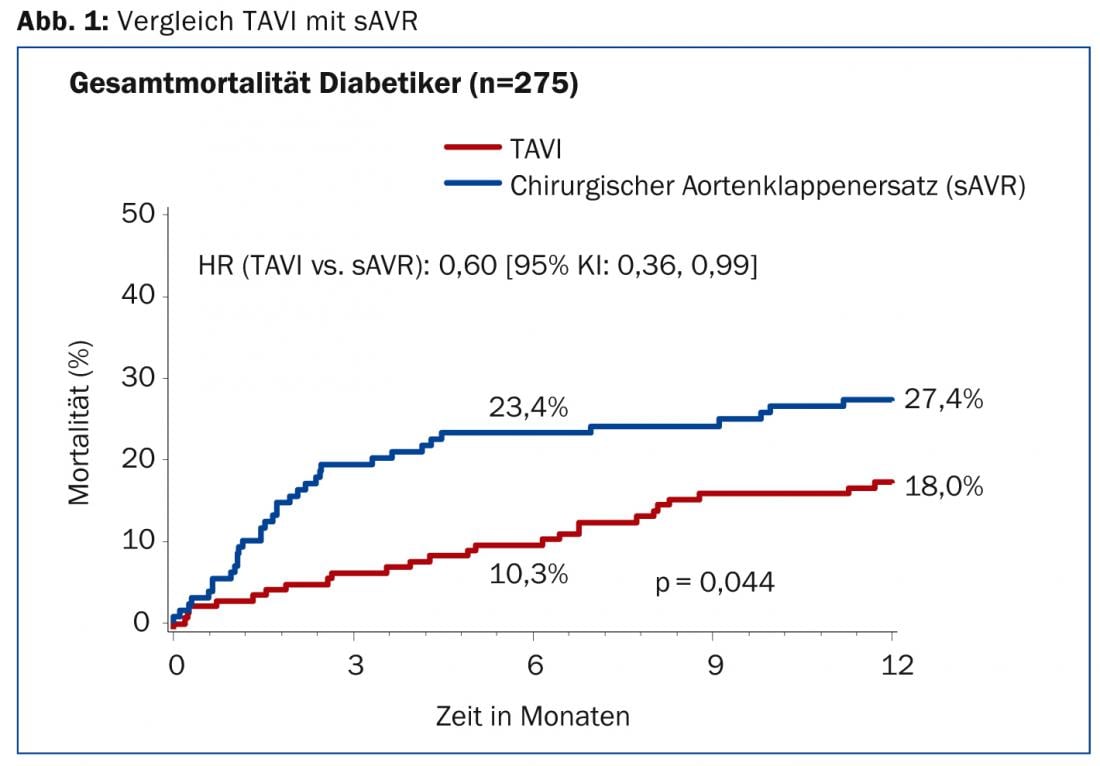The PARTNER trial was the first randomized trial to demonstrate that TAVI (transcatheter aortic valve implantation) is a valid alternative to surgical aortic valve replacement in patients at high surgical risk. A post-hoc analysis from cohort A now examined the potential benefit of TAVI in patients who also had diabetes.
(ag) The PARTNER trial was a multicenter, randomized study that enrolled 699 patients with severe symptomatic aortic valve stenosis at high surgical risk between May 2007 and August 2009. Recent post-hoc data taken from Cohort A and presented at last year’s ESC Congress [1] address a specific patient population: How does TAVI compare with surgical valve replacement in diabetic patients with severe aortic valve stenosis and high surgical risk? 275 diabetic patients (42% of all 657 patients treated) from cohort A were included in this analysis. 145 of these underwent TAVI, and 130 received surgical aortic valve replacement. Otherwise, the two groups of patients did not differ significantly in their clinical characteristics. The primary endpoint was 1-year all-cause mortality.
Diabetes as a relevant comorbidity
Patients with severe aortic valve stenosis often suffer from diabetes. This comorbidity is associated with increased morbidity and mortality after surgical aortic valve replacement. Inflammation, oxidative stress, and reperfusion injury (caused by cardiac arrest and use of the heart-lung machine) appear to be particularly deleterious, and it was hypothesized that a less invasive procedure (i.e., TAVI) might improve clinical outcomes in this population.
Results: For 1-year all-cause mortality (primary endpoint), there was a significant interaction (p=0.048) between diabetes status and treatment group (TAVI vs. surgical replacement). After twelve months, all-cause mortality was
- 18% in diabetics after TAVI
- in diabetic patients after surgical aortic valve replacement was 27.4% (Fig. 1).

Whether TAVI was via the transapical or transfemoral route made no difference. In contrast, no significant difference in all-cause mortality was observed in non-diabetic patients between the two therapies (TAVI vs. sAVR) (p=0.48).
In addition, TAVI significantly (p=0.05) reduced the need for dialysis due to renal failure at one year and, if dialysis was needed, significantly reduced the need for dialysis to be maintained for 30 days (p=0.003). These patients showed significantly lower symptomatology (NYHA III and IV) at the time of hospital discharge and 30 days thereafter. Quality of life (KCCQ) was significantly improved with TAVI at 30 days.
Relevance of the results
Post-hoc analysis suggests that diabetic patients with severe aortic valve stenosis and high surgical risk benefit more from TAVI than from surgical aortic valve replacement. In this study population, there was a 9% absolute and 35% relative reduction in all-cause mortality with TAVI no difference in the number of strokes at 1 year a lower rate of renal failure with TAVI (at 1 year) a significant improvement in symptoms with TAVI (at 30 days).
According to the authors, the analysis should give rise to further research in this area and generate new hypotheses. Because diabetes status was not a prespecified subgroup analysis in the PARTNER trial, the finding of a survival benefit in diabetic patients undergoing TAVI would need to be confirmed in the future.
Literature:
- Lindman BR, et al: Transcatheter Versus Surgical Aortic Valve Replacement in Patients With Diabetes and Severe Aortic Stenosis at High Risk for Surgery: An Analysis of the PARTNER Trial (Placement of Aortic Transcatheter Valve). J Am Coll Cardiol March 25 2014; 63(11): 1090-1099 doi:10.1016/j.jacc.2013.10.057.
HAUSARZT PRAXIS 2014; 9(7): 6











